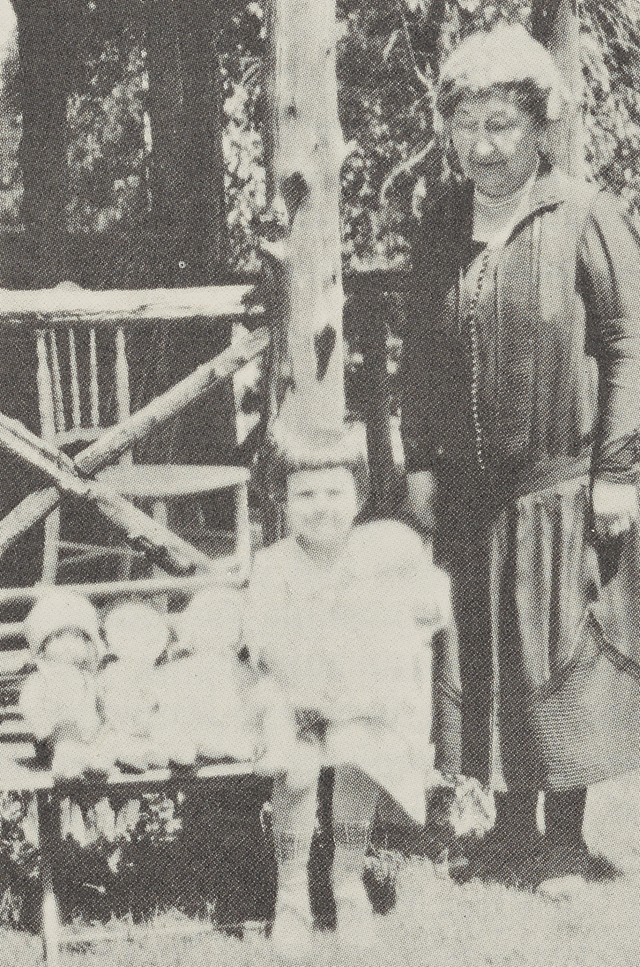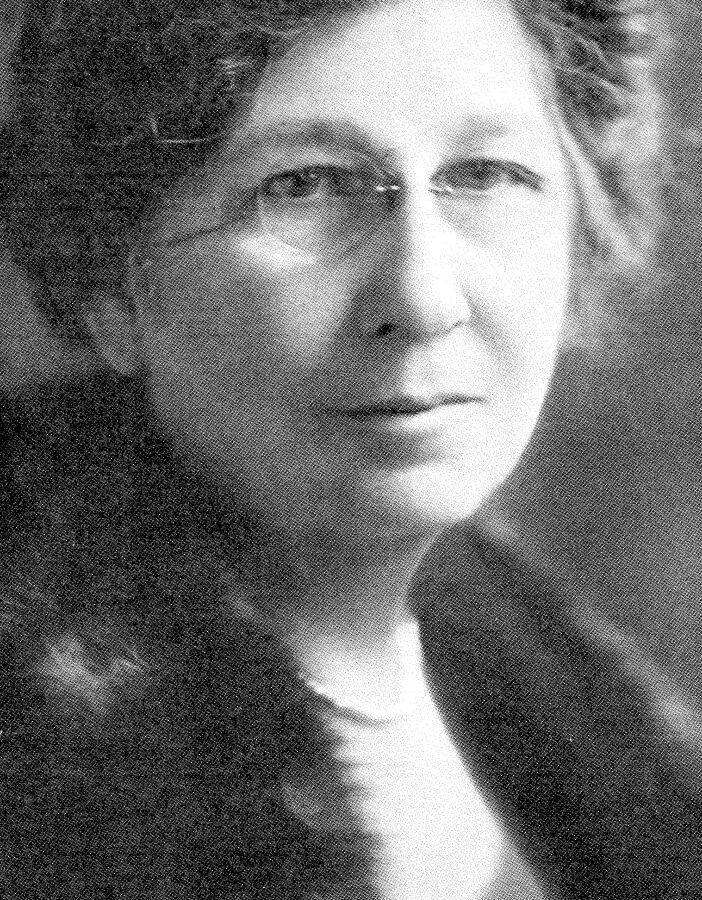Known as “Aunt Belle” to New York City’s youth, she actively supported orphans. Fund at The Trust continues her charitable legacy.
Isabel C. McKenzie (1858-1951)
I wonder why we’re given things,
Like engines and a drum,
And guns that go off with a bang,
And tops that spin and hum.
And just when we get playing good,
And have out all our toys,
Why, somebody is sure to say,
“Do stop that awful noise!”
These lines were written more than a century ago. They project the point of view of a boy, the understanding of a mother, and a psychological insight that is still valid today. Yet, the author was a woman who had no children of her own. And her insights grew from a lifelong observation of—and devotion to— young people, especially the very young. She was Isabel C. McKenzie, founder of the Isabel C. McKenzie Fund in The New York Community Trust.
Isabel McKenzie was born in Pompton Lakes, New Jersey, where her father, Richard Spear (who was born in 1820, and whose own father was born in 1783) was active in the First Reformed Church. As a young woman, she fell in love with and married a young architect, Andrew C. McKenzie, who had come down from the Lake Erie shore of western New York to make his fortune in New York City. Good fortune was his in more ways than one. He married Isabel Spear. And his young firm had the opportunity to design the New York Times Tower, a building that became an instant Times Square landmark, even before its completion.
The McKenzies settled in the Flatbush section of Brooklyn before the turn of the 20th century. They bought a home at 297 E. 18th Street, a typical Brooklyn detached house, with a broad veranda reaching close to the sidewalk in front, the width of a driveway separating the house from its neighbor on one side, and a small but well-hedged garden on the other side. Here, Isabel McKenzie made her home for more than 50 years.
The house in Flatbush became the center of Isabel’s life, and the radius of her interests extended to her husband’s business associates, her church, and children—those she knew personally and countless more she never knew.
“She was a jolly, outgoing person,” recalled one acquaintance. “She had a bouncy, cheerful disposition.” Isabel’s cheerfulness extended in warm hospitality to her husband’s many business associates and contacts, and together they enjoyed entertaining his friends in their home. “She especially liked young people,” said another friend. “When Mr. McKenzie spoke of a young man who was alone in the city, she would invite him to come for Sunday dinner with them. She was sort of a mother hen to young people who were lonely.”
Isabel also opened her home to friends who came to play bridge during the day, and to the ladies of Mrs. Field’s Literary Club, a Brooklyn organization founded in 1884 by Mary J. Field. At club meetings, she read light poems she had composed. Some found acceptance named, in the days before World War I, by the editors of Harper’s Magazine, and were published therein.
In 1914, Isabel gathered 56 of her poems that had appeared in Harper’s or had been read at club meetings. They were published in a volume titled “Through the Nursery Door” and dedicated to Andrew McKenzie. Though perhaps outdated by today’s standards, Isabel’s verse was not unlike that of Robert Louis Stevenson and Eugene Field in its detailed observation and warm understanding of early childhood. And the poetess knew how to find form that fitted function. Consider the broad boyhood truth expressed and the universal iambic couplets used in:

A BRAVE BOY
I’m not a spec afraid at night;
I go to sleep without a light;
It’s only girls and babies wee
That get scared, —not boys like me.
Oh, what’s that standing by the door?
I never saw that there before.
It’s crawling, and I hear it hum.
Oh, Mother,—Mother,—Mo-th-er! Co-me!
And note the stubborn and halting insistence of the accented first and last beats in each line of:
THE LOITERER
Little Miss Anabel Dorothy Day
Idled so many good moments away,
Seeming to think it was perfectly right
Wasting her moments from morning till night.
When the gong sounded, she never arose,
Settled herself for another short doze,
Getting to breakfast so dreadfully late,
Eating alone was her usual fate.
Really, it did seem to be her intent,
Keeping folks waiting wherever she went.
All the day long you could hear some one say:
“Hurry, Miss Anabel Dorothy Day!”
The poems of Isabel McKenzie were a way of reaching children themselves. In her garden, with its fish pool and fountain in the center, its sundial at one end and bird bath at the other, its hydrangeas in the four corners and its formal rose beds, she sat and read her poems to the neighborhood children. “She was a sort of fairy godmother to the children,” an across-the-street neighbor recalled. “It was always a great privilege for them to play in her garden and then to have lunch with her there.”
To the young people she became known as “Aunt Belle.” Many a little girl received a new doll each Christmas from her, and one remembers naming each new doll Belle. Children less fortunate than those in the neighborhood knew “Aunt Belle’s” warm interest, too, for she soon became active as a worker for the Orphan Asylum Society of the City of Brooklyn. She was elected to the society’s board of directors and served for 28 years. One of her chief projects was the annual Orphan Asylum Fair.
Andrew McKenzie’s architectural practice flourished during the first quarter of the 20th century. He became the senior partner of McKenzie, Voorhees and Gmelin, and he and his firm were responsible for designing the New York Telephone building on West Street in Manhattan, the Brooklyn Municipal Building, some 40 telephone buildings across the state of New York, and a number of U.S. government buildings erected in Washington during World War I. (It is interesting to note the persistence of McKenzie buildings: Countless Washington government buildings built for “temporary” use in 1918 were still in use when World War II erupted; the steel skeleton of the New York Times Tower became the framework of the Allied Chemical Building during the 1960s; and the New York Telephone building stands as the lone survivor in the vast area that was demolished to make way for the World Trade Center in the 1970s. Today it is known as One Hundred Barclay, and 22 floors of the 31-story Art Deco building have been converted to luxury condos.
Isabel McKenzie and her husband had become devoted members of the Lafayette Avenue Presbyterian Church. Among their closest friends in the parish were John T. and Grace Underwood, of the typewriter family. The Underwoods took a pioneer interest—some 40 years before the rest of the nation—in the plight of people who lived in the Cumberland plateau, later known as Appalachia. They led the Lafayette Avenue Presbyterian Church in establishing a mission branch in Buckhorn, Kentucky, about 100 miles southeast of Lexington. With headquarters in Brooklyn, the Buckhorn Association went to work sponsoring and developing a center in Buckhorn for children in the surrounding area.
Isabel McKenzie approved of the idea and saw the need. When the center was built, the McKenzie Dining Hall, an imposing, two-story building of huge, native, square-hewn logs and chinking, was its most integral structure. As the Buckhorn Children’s Center grew, the McKenzies added a substantial kitchen wing to the dining hall. Children far from Brooklyn benefited from the loving interest of Flatbush’s Belle McKenzie.
The New York Community Trust was scarcely two years old in 1925, when Andrew and Isabel McKenzie, who were then in their 60s, discussed with their lawyer the possibility of creating, through bequest, a fund in the Trust. Less than a year later, Andrew McKenzie died suddenly of a heart attack. His widow, mindful of the uncertainty of human life, began making plans for her residual estate to help others.
“But she had a long and bright and alert old age,” recalled a friend. “With her happy disposition, she came back after her grief and resumed her activities.” Included were a trip to Europe with the Underwoods when Isabel McKenzie was in her 70s, and a North Cape Cruise at the age of 80 with Grace Underwood after her husband died. “Her mind was always very keen,” another friend said. “She could toss off rhymes and jingles in no time.”
The elderly Isabel McKenzie maintained her interest in children. Neighborhood youngsters were always welcome in her home. “She loved to make a fuss over my kids,” said one neighbor. In her late 80s, she was less able to get around, and she depended on her chauffeur, Philip Cousins, to make purchases and handle details she had always handled herself. One by one, neighborhood friends of many years moved or passed away.
When Isabel died in 1951, she was almost 93. All who had known her remembered her devotion to the very young, but few remembered one probable cause of that devotion: Her only child had died in infancy. And even fewer knew that at some time Belle McKenzie had been writing a book of children’s stories. The unpublished manuscript was found in her home after her death.
Today, her legacy continues through grants made from her unrestricted fund.
